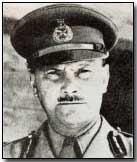Who's Who - Bernard Freyberg
 Bernard Cyril Freyberg (1889-1963)
earned the Victoria Cross for courage on the Somme in November 1916 plus a
further four DSOs for similar acts of bravery.
Bernard Cyril Freyberg (1889-1963)
earned the Victoria Cross for courage on the Somme in November 1916 plus a
further four DSOs for similar acts of bravery.
Freyberg, who was born in Britain but raised in New Zealand, qualified as a dentist in 1911 but sought (and received) a commission into the New Zealand Territorials in 1912. The following year Freyberg abruptly switched careers by becoming a ship's stoker.
In London when war broke out in 1914 Freyberg met and persuaded the First Lord of the Admiralty Winston Churchill to give him a commission into the Hood Battalion of the infant Royal Naval Division.
Having served during the defence of Antwerp with the Royal Naval Division in August 1914 Freyberg was posted to Gallipoli where after a remarkable performance during the initial landings (when he swam from ship to ship lighting flares as part of a deception operation, earning him a DSO) he served until the Allied evacuation.
As with many ex-Gallipoli soldiers Freyberg's next destination was the Western Front. It was while serving on the River Ancre during the tail-end of the Allied Somme Offensive that Freyberg earned a Victoria Cross for refusing to leave the Hood Battalion in spite of suffering no fewer than four wounds in the space of 24 hours. He had earlier led his battalion's attack at Beaucourt which resulted in the capture of 500 prisoners.
The following year brought Freyberg a promotion on 21 April 1917 to Brigadier-General - making him at 27 the youngest in the British Army. He was given a brigade and then a divisional (29th) command. By the armistice he had been wounded on nine occasions.
Freyberg's military career did not end in November 1918 however. He served variously in command and staff roles until the onset of the Second World War, when he was handed command of New Zealand forces in the Mediterranean.
In April 1941 Freyberg played a role in the defence of Greece and subsequently led British and Greek troops on Crete until their humiliating defeat which owed at least something to his weak leadership.
Next came service as a Corps commander in 8th Army in the Western Desert in North Africa, during the course of which he saw action at the Second Battle of Sidi Rezegh and at Minqar Qaim (where he was further wounded).
Having played a prominent role during the Second Battle of El Alamein in November 1942 he led the flanking force en route to Tunisia. His next role was as commander of New Zealand forces in Italy, which culminated with his troops entering Trieste in triumph on 2 May 1945.
With his remarkably distinguished - and award-laden - military career drawing to a close, during the course of which he had earned no fewer than four DSOs in addition the Victoria Cross and rose to the rank of Lieutenant-General, Freyberg subsequently served as New Zealand Governor-General in 1946.
Made a baron (of Wellington and Munstead) in 1951, Freyberg died in 1963.
Britain introduced conscription for the first time on 2 February 1916.
- Did you know?
